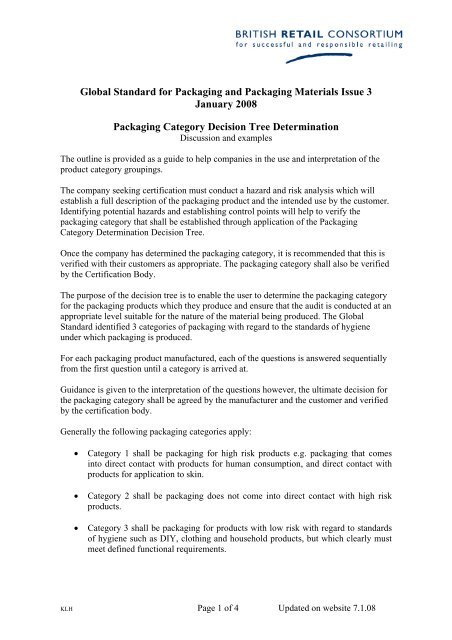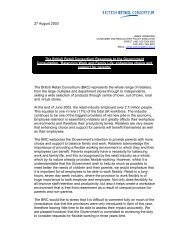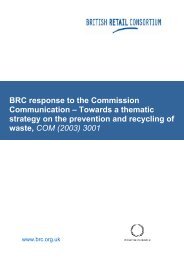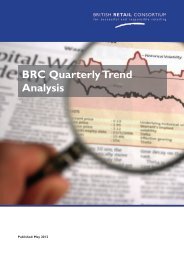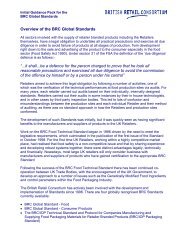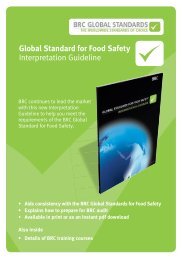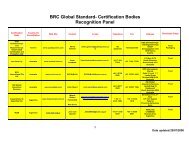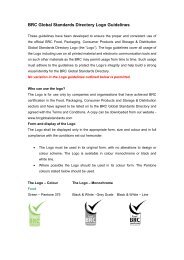Global Standard for Packaging and Packaging Materials Issue 3 ...
Global Standard for Packaging and Packaging Materials Issue 3 ...
Global Standard for Packaging and Packaging Materials Issue 3 ...
Create successful ePaper yourself
Turn your PDF publications into a flip-book with our unique Google optimized e-Paper software.
<strong>Global</strong> <strong>St<strong>and</strong>ard</strong> <strong>for</strong> <strong>Packaging</strong> <strong>and</strong> <strong>Packaging</strong> <strong>Materials</strong> <strong>Issue</strong> 3<br />
January 2008<br />
<strong>Packaging</strong> Category Decision Tree Determination<br />
Discussion <strong>and</strong> examples<br />
The outline is provided as a guide to help companies in the use <strong>and</strong> interpretation of the<br />
product category groupings.<br />
The company seeking certification must conduct a hazard <strong>and</strong> risk analysis which will<br />
establish a full description of the packaging product <strong>and</strong> the intended use by the customer.<br />
Identifying potential hazards <strong>and</strong> establishing control points will help to verify the<br />
packaging category that shall be established through application of the <strong>Packaging</strong><br />
Category Determination Decision Tree.<br />
Once the company has determined the packaging category, it is recommended that this is<br />
verified with their customers as appropriate. The packaging category shall also be verified<br />
by the Certification Body.<br />
The purpose of the decision tree is to enable the user to determine the packaging category<br />
<strong>for</strong> the packaging products which they produce <strong>and</strong> ensure that the audit is conducted at an<br />
appropriate level suitable <strong>for</strong> the nature of the material being produced. The <strong>Global</strong><br />
<strong>St<strong>and</strong>ard</strong> identified 3 categories of packaging with regard to the st<strong>and</strong>ards of hygiene<br />
under which packaging is produced.<br />
For each packaging product manufactured, each of the questions is answered sequentially<br />
from the first question until a category is arrived at.<br />
Guidance is given to the interpretation of the questions however, the ultimate decision <strong>for</strong><br />
the packaging category shall be agreed by the manufacturer <strong>and</strong> the customer <strong>and</strong> verified<br />
by the certification body.<br />
Generally the following packaging categories apply:<br />
• Category 1 shall be packaging <strong>for</strong> high risk products e.g. packaging that comes<br />
into direct contact with products <strong>for</strong> human consumption, <strong>and</strong> direct contact with<br />
products <strong>for</strong> application to skin.<br />
• Category 2 shall be packaging does not come into direct contact with high risk<br />
products.<br />
• Category 3 shall be packaging <strong>for</strong> products with low risk with regard to st<strong>and</strong>ards<br />
of hygiene such as DIY, clothing <strong>and</strong> household products, but which clearly must<br />
meet defined functional requirements.<br />
KLH Page 1 of 4 Updated on website 7.1.08
It is recognised that many manufacturers or suppliers fall into more than one Category. In<br />
these circumstances they may either choose to use one category <strong>for</strong> the entire factory or<br />
separate them by areas. It is not envisaged that more than one category would apply within<br />
the same area.<br />
Is the packaging intended <strong>for</strong> a high risk product – For example food or cosmetics<br />
products?<br />
A high risk product has been defined in the glossary as:<br />
‘those products intended <strong>for</strong> human consumption or which will come into close contact<br />
with the body such as application to the skin or are intended <strong>for</strong> infants.’<br />
Infants are defined as children under the age of 36 months.<br />
This question is intended to identify the initial hygiene requirement <strong>for</strong> the packaging.<br />
Although it can be said that clothing such as hosiery, lingerie, shirts <strong>and</strong><br />
blouses are designed to come into close contact with the skin, these would not be<br />
considered ‘high risk’ products <strong>and</strong> so the answer here would be ‘no’ <strong>and</strong> packaging <strong>for</strong><br />
such clothing would be category 3.<br />
Jewellery is also an example of a product that technically could be in contact with the<br />
skin, but in most cases would be identified as category 3.<br />
Products which would be considered as high risk are:<br />
Those <strong>for</strong> human consumption would include foods <strong>and</strong> medicines. Medicines would be<br />
include any product that is controlled under the medicines directives (legislation) where<br />
the product is sold. Products that are defined as medicines in the EU many not be defined<br />
as such in other countries such as the USA.<br />
It may be agreed by the manufacturer <strong>and</strong> customer that consumed products other than<br />
those <strong>for</strong> humans e.g. pet foods may fall into a high risk product group <strong>and</strong> there<strong>for</strong>e<br />
category 1.<br />
Products that would come into close contact with the skin may include:<br />
Cosmetics – Any product that is controlled under the Cosmetic directives (legislation)<br />
where the product is sold. In the UK a non woven product such as a cosmetic wipe would<br />
be sold as a cosmetic <strong>and</strong> would be defined under the legislation as such. Examples of<br />
other typical products that would be sold as cosmetics include cosmetic wipes such as<br />
make up remover wipes, baby wipes, medicated shampoo, perfumes, anti wrinkle creams,<br />
lipsticks <strong>and</strong> moisturisers.<br />
Medical Device- Any product that is controlled under the legislation as a medical device<br />
in the country where the product is sold. In the UK plasters that are designed to put over<br />
wounds <strong>and</strong> incontinence pants are both defined under the legislation as medical devices.<br />
Other examples of typical medical devices would include wound plasters, incontinence<br />
pads, condoms, contact lenses, <strong>and</strong> supportive b<strong>and</strong>ages.<br />
KLH Page 2 of 4 Updated on website 7.1.08
Is the packaging intended <strong>for</strong> direct contact with a high risk product?<br />
It must then be determined whether the packaging will come into direct contact with the<br />
high risk product.<br />
Does the high risk product have an adequate natural barrier?<br />
A natural barrier here would apply to foods such eggs, avocado, nuts or banana where the<br />
shell or peel is not traditionally eaten. For foods such as oranges, it must be agreed<br />
whether this constitutes a natural barrier as in some instances the peel itself would be<br />
eaten. Examples of other food stuffs such as sacks <strong>for</strong> potatoes could be included here.<br />
Is it intended that the packaging will enter an environment where there are<br />
unprotected or open high risk products?<br />
This examines the need <strong>for</strong> higher hygiene practices to be applied if the packaging is<br />
likely to enter the high risk production environment, even though it may not in itself come<br />
into contact with the high risk product, <strong>for</strong> example labels which would be applied to outer<br />
packaging of food.<br />
Is the product already in impermeable packaging?<br />
Impermeable (a material through which substances, such as liquids or gases, cannot pass)<br />
would be defined as a can, bottle or the like where the food product is packed <strong>and</strong> sealed<br />
<strong>and</strong> cannot be contaminated during labelling or further packed in an outer container.<br />
Does the packaging have the potential to contaminate the product?<br />
It should be considered what the contamination potential of the packaging to the high risk<br />
product is. This poses the question of whether the packaging or its constituent parts could<br />
contaminate the product or impart any flavours, colorants, loose fibres, clips, adhesive or<br />
any other item onto the food or skin contact packaging. For example it must be ensured<br />
that the packaging itself would not allow migration of chemicals <strong>for</strong> example that could<br />
contaminate food or leach into cream that would be subsequently applied to skin <strong>for</strong><br />
example. This may not be an issue <strong>for</strong> products within category 3 <strong>for</strong> example. However,<br />
it should be noted that all products should con<strong>for</strong>m to legislation <strong>and</strong> there<strong>for</strong>e this hazard<br />
should have been considered within the hazard <strong>and</strong> risk analysis.<br />
KLH Page 3 of 4 Updated on website 7.1.08
Worked Examples<br />
1. Plastic laminate <strong>for</strong> toothpaste tube<br />
Is the packaging intended <strong>for</strong> a high risk product – For example food or cosmetics<br />
products?<br />
Yes – as this product is ingested<br />
Is the packaging intended <strong>for</strong> direct contact with a high risk product?<br />
Yes – comes into direct contact with toothpaste<br />
Does the high risk product have an adequate natural barrier?<br />
No<br />
CATEGORY 1<br />
2. Cardboard outer box <strong>for</strong> cornflakes<br />
Is the packaging intended <strong>for</strong> a high risk product – For example food or cosmetics<br />
products?<br />
Yes – food product<br />
Is the packaging intended <strong>for</strong> direct contact with a high risk product?<br />
No – outer packaging only, as cornflakes are in inner bag<br />
Is it intended that the packaging will enter an environment where there are<br />
unprotected or open high risk products?<br />
Yes – may enter production environment whether cornflakes are packed<br />
Does the packaging have the potential to contaminate the product?<br />
Production environment <strong>and</strong> procedures designed so that packing is remote from open<br />
product <strong>and</strong> little potential <strong>for</strong> contamination<br />
CATEGORY 2<br />
3. Plastic bag <strong>for</strong> nails<br />
Is the packaging intended <strong>for</strong> a high risk product – For example food or cosmetics<br />
products?<br />
No – low risk nails<br />
CATEGORY 3<br />
KLH Page 4 of 4 Updated on website 7.1.08


